MARCH 2021 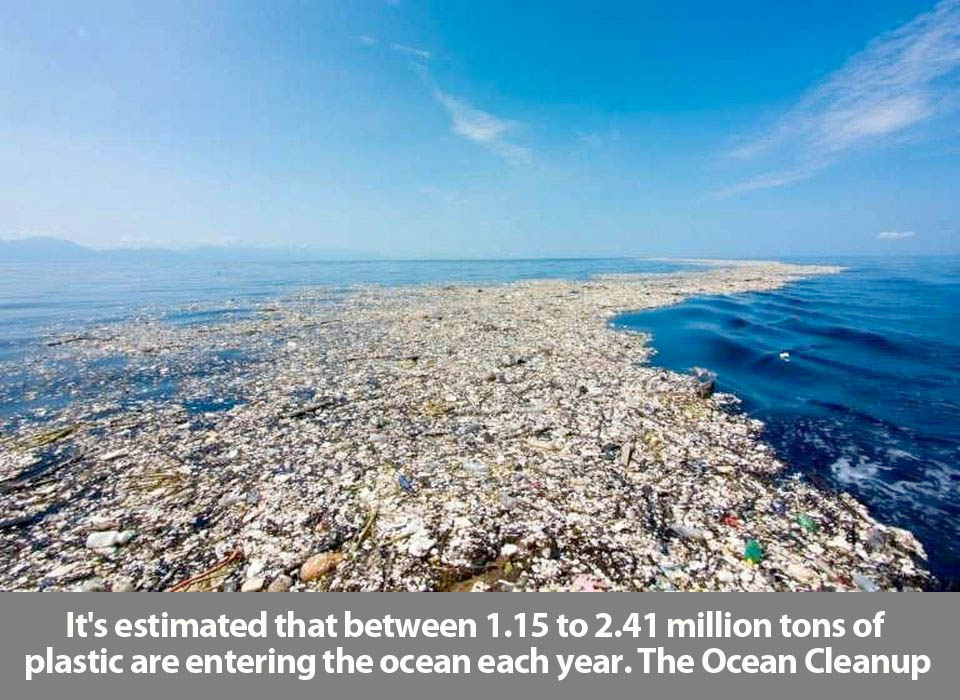 Ocean pollution poses a grave threat to both human and marine life. Several studies made headlines this month detailing the negative impacts of human debris in the sea. Ranging from plastic gyres swirling in the Great Pacific Garbage Patch to invisible yet insidious chemicals, fertilizers, pesticides, and mercury washing into the ocean, anthropogenic pollution takes many forms––including sound––and knows few boundaries. Such a slew of pollutants harms human health and fertility as well as marine ecosystems. We understand the risks. But will we act on such threats? Ocean pollution poses a grave threat to both human and marine life. Several studies made headlines this month detailing the negative impacts of human debris in the sea. Ranging from plastic gyres swirling in the Great Pacific Garbage Patch to invisible yet insidious chemicals, fertilizers, pesticides, and mercury washing into the ocean, anthropogenic pollution takes many forms––including sound––and knows few boundaries. Such a slew of pollutants harms human health and fertility as well as marine ecosystems. We understand the risks. But will we act on such threats? 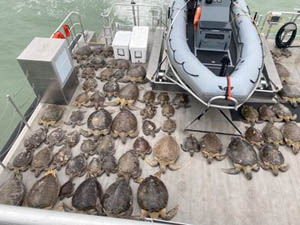 Human and marine life are also affected by our increasingly turbulent climate. As a harsh winter storm in Texas left millions without power, hitting minority communities the hardest, thousands of cold-stunned turtles washed ashore on Texas beaches. Tireless volunteers at Sea Turtle Inc. rescued 3,500 turtles. Unfortunately, climate change means that such extreme events aren’t going away. The gulf stream, a climate-moderating ocean current, is at its weakest in a millennium. Additionally, a new report estimates sea levels are rising faster, and the effects will be costlier, than we thought. Human and marine life are also affected by our increasingly turbulent climate. As a harsh winter storm in Texas left millions without power, hitting minority communities the hardest, thousands of cold-stunned turtles washed ashore on Texas beaches. Tireless volunteers at Sea Turtle Inc. rescued 3,500 turtles. Unfortunately, climate change means that such extreme events aren’t going away. The gulf stream, a climate-moderating ocean current, is at its weakest in a millennium. Additionally, a new report estimates sea levels are rising faster, and the effects will be costlier, than we thought. Despite all these threats, we can restore and protect the ocean. And there are so many unsung heroes, such as Black activist MaVynee Betsch, who dedicated her life to protecting the coast. Continue reading for the latest ocean news, events, and films curated by the RCC. Recent News Ocean Pollution Threatens Human and Marine Life Why Ocean Pollution is a Clear Danger to Human Health 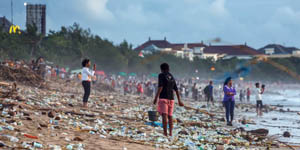 Ocean pollution is widespread, worsening, and poses a clear and present danger to human health and wellbeing. But the extent of this danger has not been widely comprehended – until now. Our recent study provides the first comprehensive assessment of the impacts of ocean pollution on human health. Ocean pollution is widespread, worsening, and poses a clear and present danger to human health and wellbeing. But the extent of this danger has not been widely comprehended – until now. Our recent study provides the first comprehensive assessment of the impacts of ocean pollution on human health. Ocean pollution is a complex mixture of toxic metals, plastics, manufactured chemicals, petroleum, urban and industrial wastes, pesticides, fertilisers, pharmaceutical chemicals, agricultural runoff, and sewage. More than 80% arises from land-based sources and it reaches the oceans through rivers, runoff, deposition from the atmosphere – where airborne pollutants are washed into the ocean by rain and snow – and direct dumping, such as pollution from waste water treatment plants and discarded waste. Ocean pollution is heaviest near the coasts and most highly concentrated along the coastlines of low-income and middle-income countries. Read more at The Conversation In the Oceans, the Volume Is Rising as Never Before 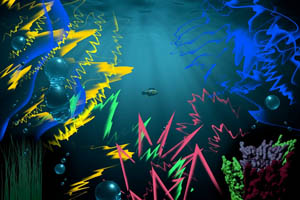 Although clown fish are conceived on coral reefs, they spend the first part of their lives as larvae drifting in the open ocean. The fish are not yet orange, striped or even capable of swimming. They are still plankton, a term that comes from the Greek word for “wanderer,” and wander they do, drifting at the mercy of the currents in an oceanic rumspringa. Although clown fish are conceived on coral reefs, they spend the first part of their lives as larvae drifting in the open ocean. The fish are not yet orange, striped or even capable of swimming. They are still plankton, a term that comes from the Greek word for “wanderer,” and wander they do, drifting at the mercy of the currents in an oceanic rumspringa.
When the baby clown fish grow big enough to swim against the tide, they high-tail it home. The fish can’t see the reef, but they can hear its snapping, grunting, gurgling, popping and croaking. These noises make up the soundscape of a healthy reef, and larval fish rely on these soundscapes to find their way back to the reefs, where they will spend the rest of their lives — that is, if they can hear them. Read more at The New York Times Deep-Sea Snail Builds Its Own Ironclad Suit of Armor. But Even That Can’t Protect It From Ocean Mining 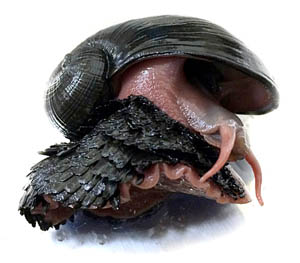 The sea pangolin only lives by a few hydrothermal vents in the Indian Ocean, which are being targeted by deep-sea miners. The sea pangolin only lives by a few hydrothermal vents in the Indian Ocean, which are being targeted by deep-sea miners.
Lots of species are added to the International Union for the Conservation of Nature’s Red List, the international endangered species list, each year. But the addition of a strange little deep-sea scaly foot snail called the sea pangolin (Chrysomallon squamiferum) is the first time a creature has been declared endangered due to the threat of deep sea mining, a technology that has yet to be fully developed. Read more at Smithsonian Magazine Beneath the Blue: Dive Into a Dazzling Ocean Under Threat – Interactive 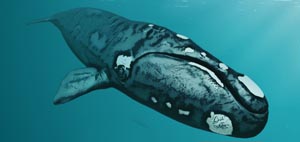 Descend through the different zones of the ocean to discover its mesmerising marine life, how human pollutants are interfering – and what we can still do about it. The glimmering surface attracts many animals that must breathe air, like whales. But this puts them at risk. Descend through the different zones of the ocean to discover its mesmerising marine life, how human pollutants are interfering – and what we can still do about it. The glimmering surface attracts many animals that must breathe air, like whales. But this puts them at risk.
To the casual observer, the ocean appears vast, featureless and pristine. But look beneath the surface… The North Atlantic right whale are near extinction: only about 350 are left. Many are killed by fishing equipment, including abandoned gear or “ghost gear”. Read more at The Guardian Beaches and Black History The Unsung Hero Who Saved A Florida Beach  The fact you don’t hear MaVynee Oshun Betsch mentioned alongside conservationists like John Muir, Aldo Leopold, and perhaps Rachel Carson says more about who we enshrine in history books than Betsch’s remarkable contributions to the environmental movement and her valiant campaign to save a landmark of Black history. The fact you don’t hear MaVynee Oshun Betsch mentioned alongside conservationists like John Muir, Aldo Leopold, and perhaps Rachel Carson says more about who we enshrine in history books than Betsch’s remarkable contributions to the environmental movement and her valiant campaign to save a landmark of Black history.
Betsch was born in 1935 to wealth, and embarked on an international career as an opera singer before returning to her Florida hometown and donating most of her fortune to a long list of environmental causes. But even that pales alongside her dedication to preserving American Beach, a dune-dappled stretch of sand 40 miles northwest of Jacksonville that was among the most popular vacation spots for African Americans during the Jim Crow era. Read more at Grist Saving Sea Turtles More Than 3,500 Turtles Are Rescued From Texas Cold 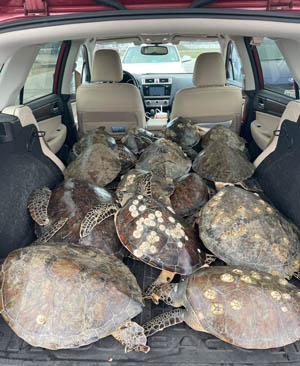 The dramatic cold snap that devastated Texas's power grid also had a major impact on the state's nonhuman inhabitants. In particular, the freezing temperatures are cold stunning endangered sea turtles — making them so cold that they lose the ability to swim or feed. The dramatic cold snap that devastated Texas's power grid also had a major impact on the state's nonhuman inhabitants. In particular, the freezing temperatures are cold stunning endangered sea turtles — making them so cold that they lose the ability to swim or feed.
"You could put a cold-stunned turtle in a half an inch of water and they'd drown," Wendy Knight, executive director of conservation nonprofit Sea Turtle Inc., told The New York Times.
Turtles can become cold stunned when temperatures fall below 50 degrees Fahrenheit, according to The Washington Post. But that is unusual for South Padre Island, a beach town at the southern tip of Texas where Sea Turtle Inc. is located. Usually, volunteers might rescue dozens to hundreds of cold-stunned turtles. But by Tuesday, the group wrote on Facebook that they were caring for more than 2,500 turtles. By late Tuesday, more than 3,500 turtles had been rescued and brought to the town's convention center, where they were being warmed in kiddie pools and tarps, The Washington Post reported. Read more at EcoWatch Why Care About a Sea Turtle? 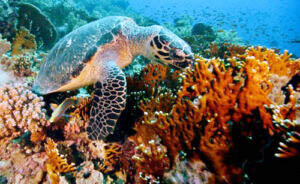 The wind whistled in my ears, rippling the sea lapping at the rocks below me. Under the wrinkled surface of the shallows, a green sea turtle swam languidly among the sea grasses. It was a small turtle, no larger than a dinner plate. I leaned against the railing of the sea wall, watching in rapture as the turtle ambled, in movements more peaceful and placid than the ocean, among the underwater meadows. I had walked along the sea wall almost every afternoon during my summer researching at the Duke Marine Lab, fixing my eyes on the water in hopes of spying some sign of a turtle: the flat, glossy back of a shell, a blip in the water’s wavy signature. The wind whistled in my ears, rippling the sea lapping at the rocks below me. Under the wrinkled surface of the shallows, a green sea turtle swam languidly among the sea grasses. It was a small turtle, no larger than a dinner plate. I leaned against the railing of the sea wall, watching in rapture as the turtle ambled, in movements more peaceful and placid than the ocean, among the underwater meadows. I had walked along the sea wall almost every afternoon during my summer researching at the Duke Marine Lab, fixing my eyes on the water in hopes of spying some sign of a turtle: the flat, glossy back of a shell, a blip in the water’s wavy signature. When I finally saw the turtle, I stood in stillness as the sea-wind whipped around me. I remembered why I decided to pursue a degree in environmental science and a career in conservation. I chose this path to advocate for threatened species, to restore marine environments degraded by pollution and development. It is a path that led me to the very stretch of North Carolina coast that Rachel Carson wrote about in Under the Sea-Wind. Read more at RCC Sea Level Rise: More Rapid and Costly than We Thought How to Save Saltwater Wetlands From Rising Seas 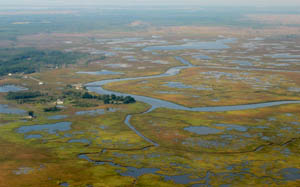 America’s coastal saltwater wetlands are on a course toward functional extinction in the coming decades. Their demise will come at the hands of steadily accelerating sea-level rise and relentless coastal development. As these wetlands disappear, they will take with them habitat, storm buffering and carbon sequestration benefits of tremendous value. America’s coastal saltwater wetlands are on a course toward functional extinction in the coming decades. Their demise will come at the hands of steadily accelerating sea-level rise and relentless coastal development. As these wetlands disappear, they will take with them habitat, storm buffering and carbon sequestration benefits of tremendous value.
Fortunately, there is still time to change course. A determined and coordinated effort by local, state and federal governments — led by the Biden administration — could dramatically increase the number of saltwater wetlands that survive and go a long way to maintaining their ecological and societal benefits into the future. Read more at The Revelator Sea Level Rising More Rapidly: ‘Report Cards’ 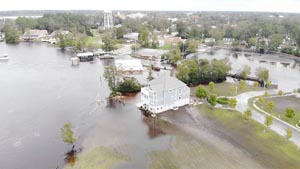 College of William & Mary’s Virginia Institute of Marine Sciences recently released its latest annual U.S. Sea-Level Report Cards, drawing on a collection of data that includes water level analysis from the past 52 years. College of William & Mary’s Virginia Institute of Marine Sciences recently released its latest annual U.S. Sea-Level Report Cards, drawing on a collection of data that includes water level analysis from the past 52 years.
Consistent with preceding years, this year’s collection of trends, projections and explanations shows that in most places, sea levels have been rising in year-to-year comparisons, but the rate is faster than in previous decades. The institute uses 32 tide gauges placed in ports and harbors across the country, from Wilmington all the way to the banks of Alaska. These tide gauges are maintained by the National Oceanic and Atmospheric Administration, and they take measurements every six minutes. Read more at Coastal Review Climate Change, Rising Sea Levels to Increase Cost of Flood Damage by $34 Billion in Coming Decades: Report 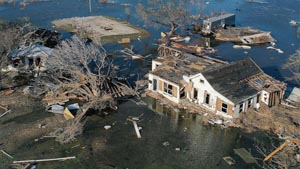 The cost of climate change is becoming increasingly clear as researchers study the adverse effects of rising sea levels on society. The cost of climate change is becoming increasingly clear as researchers study the adverse effects of rising sea levels on society.
As the climate warms, the glaciers and ice sheets around the world will melt, causing sea levels to rise and leading to disastrous consequences for coastal cities in the coming decades, according to a new report titled "The Cost of Climate" by research and technology nonprofit First Street Foundation. By 2051, the cost of flood damage is expected to increase by 61%, or $32 billion, according to researchers, who analyzed the economic impact of underestimated flood risk to properties throughout the U.S. Read more at ABC News Ocean Protection The Presidential Power of Marine National Monuments 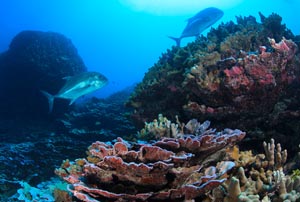 Much as our national parks on land are some of our greatest natural treasures, marine national monuments safeguard precious ecosystems and protect them now and for future generations. Much as our national parks on land are some of our greatest natural treasures, marine national monuments safeguard precious ecosystems and protect them now and for future generations.
The National Marine Sanctuary System encompasses more than 600,000 square miles of marine and Great Lakes waters, and contains amazing cultural and historical resources, as well as vibrant ecosystems as diverse as coral reefs and kelp forests. Marine national monuments are designated by presidential proclamation under the Antiquities Act of 1906, which authorizes the president to establish national monuments on federal lands that contain “historic landmarks, historic and prehistoric structures, and other objects of historic or scientific interest.” Read more at Our Daily Planet New Report Provides Roadmap for Fully Protected Oceans 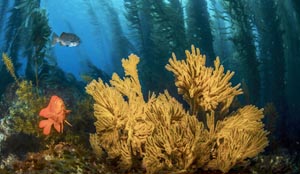 Each year, the ocean removes almost a third of all global CO2 emissions. But as the ocean warms, it’s becoming less effective as a carbon sink and could release billions of tons of carbon back into the atmosphere. More ocean protections are needed to ensure the ocean remains healthy given the “stress” of all this carbon, plus pollution and loss of biomass (fish and other living species). Each year, the ocean removes almost a third of all global CO2 emissions. But as the ocean warms, it’s becoming less effective as a carbon sink and could release billions of tons of carbon back into the atmosphere. More ocean protections are needed to ensure the ocean remains healthy given the “stress” of all this carbon, plus pollution and loss of biomass (fish and other living species). Recently, with the support of 450 elected officials, President Biden signed an executive order to protect 30% of all U.S. land and waters by 2030. Currently, only about 5% of our oceans are fully protected. What counts as “protected” can be a broad category of policies. To achieve real and effective protection (as opposed to parks with no monitoring and enforcement of restrictions) for land, wildlife and to fight climate change, the Biden-Harris administration will need to balance the needs of sustainable blue jobs in offshore wind, shipping, recreation, and tourism, and fishing with the need for conservation of the ocean. Read more at Our Daily Planet Oceans and Climate Change Arctic Ice Loss Forces Polar Bears to Use Four Times as Much Energy to Survive – Study 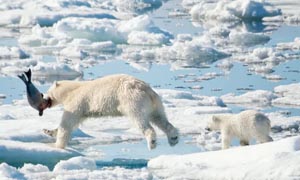 Polar bears and narwhals are using up to four times as much energy to survive because of major ice loss in the Arctic, according to scientists. Polar bears and narwhals are using up to four times as much energy to survive because of major ice loss in the Arctic, according to scientists.
Once perfectly evolved for polar life, apex predators are struggling as their habitats shrink and unique adaptations become less suited to an increasingly ice-free Arctic, researchers say. The mammals are physiologically designed to use as little energy as possible. Polar bears are primarily “sit and wait” hunters, adapted to catching seals by breathing holes, and narwhals have evolved to dive very deep for prey without making fast movements. Now, however, they are having to work much harder to stay alive, according to a review article published in Journal of Experimental Biology. Read more at The Guardian Gulf Stream System at Its Weakest in Over A Millennium 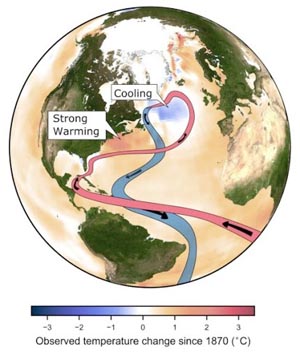 Never before in over 1000 years the Atlantic Meridional Overturning Circulation (AMOC), also known as Gulf Stream System, has been as weak as in the last decades. This is the result of a new study by scientists from Ireland, Britain and Germany. The researchers compiled so-called proxy data – taken mainly from natural archives like ocean sediments or ice cores – reaching back many hundreds of years to reconstruct the flow history of the AMOC. They found consistent evidence that its slowdown in the 20th century is unprecedented in the past millennium – it is likely linked to human-caused climate change. The giant ocean circulation is relevant for weather patterns in Europe and regional sea-levels in the US; its slowdown is also associated with an observed ‘cold blob’ in the northern Atlantic. Read more at Potsdam Institute for Climate Impact Research Never before in over 1000 years the Atlantic Meridional Overturning Circulation (AMOC), also known as Gulf Stream System, has been as weak as in the last decades. This is the result of a new study by scientists from Ireland, Britain and Germany. The researchers compiled so-called proxy data – taken mainly from natural archives like ocean sediments or ice cores – reaching back many hundreds of years to reconstruct the flow history of the AMOC. They found consistent evidence that its slowdown in the 20th century is unprecedented in the past millennium – it is likely linked to human-caused climate change. The giant ocean circulation is relevant for weather patterns in Europe and regional sea-levels in the US; its slowdown is also associated with an observed ‘cold blob’ in the northern Atlantic. Read more at Potsdam Institute for Climate Impact Research Take Action 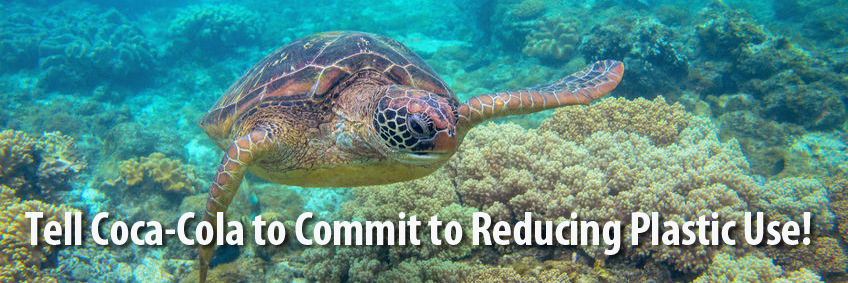 Events & Films  This stunning documentary series narrated by David Attenborough details both the wonder and peril of Earth’s ecosystems. Ocean lovers in particular will delight in three marine episodes: Coastal Seas, Frozen Worlds, and the High Seas. Streaming now on Netflix, Our Planet is an informative and interesting watch for all ages and interests. Coastal Seas captures the clever foraging techniques and social behavior of bottlenose dolphins and humpback whales, instilling empathy for these marine mammals with family structures and bonds so similar to our own. Coastal Seas also tells the story of Raja Ampat, Indonesia, where the establishment of a marine protected area restores a coral reef to its former vibrancy, Frozen Worlds chills with breathtaking beauty of glaciers, the resilience of penguins, and the plight of polar bears facing melting Arctic ice. The High Seas explores the wild and ungoverned high seas, peering into the lives of blue whales, sharks, turtles, tuna and mysterious deep-sea animals. Read more at Atlantic This stunning documentary series narrated by David Attenborough details both the wonder and peril of Earth’s ecosystems. Ocean lovers in particular will delight in three marine episodes: Coastal Seas, Frozen Worlds, and the High Seas. Streaming now on Netflix, Our Planet is an informative and interesting watch for all ages and interests. Coastal Seas captures the clever foraging techniques and social behavior of bottlenose dolphins and humpback whales, instilling empathy for these marine mammals with family structures and bonds so similar to our own. Coastal Seas also tells the story of Raja Ampat, Indonesia, where the establishment of a marine protected area restores a coral reef to its former vibrancy, Frozen Worlds chills with breathtaking beauty of glaciers, the resilience of penguins, and the plight of polar bears facing melting Arctic ice. The High Seas explores the wild and ungoverned high seas, peering into the lives of blue whales, sharks, turtles, tuna and mysterious deep-sea animals. Read more at Atlantic Webinar: A Conversation with Helen Scales 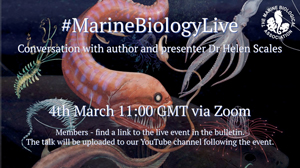 From the hidden life of the deep sea, to the strange biology of seahorses and the spiraling mathematics of sea shells, Dr. Helen Scales has written and talked about all sorts of marine topics in her work as an author and presenter specializing in the ocean. From the hidden life of the deep sea, to the strange biology of seahorses and the spiraling mathematics of sea shells, Dr. Helen Scales has written and talked about all sorts of marine topics in her work as an author and presenter specializing in the ocean.
Join the Marine Biological Station on Thursday March 4th at 11 am GMT to hear about her latest books and new podcast series Catch Our Drift. Her talk will be uploaded to the Marine Biological Association’s YouTube channel after the event. Read more and sign up at MarineBio Webinar: Shifting MPAs for Conservation and Fisheries under a Changing Climate  Marine species are shifting their distribution towards colder waters because of climate change, potentially compromising the benefits and management objectives of currently established Marine Protected Areas (MPAs). It remains unclear what the long-term effectiveness of MPAs for conservation, fisheries, and reliant communities is under a changing climate. On Tuesday, March 23rd at 1 pm EST, scientists from NOAA, Duke University, Ocean Nexus Center, Nazarbayev University, and University of British Columbia will present their research findings. Click here to register Marine species are shifting their distribution towards colder waters because of climate change, potentially compromising the benefits and management objectives of currently established Marine Protected Areas (MPAs). It remains unclear what the long-term effectiveness of MPAs for conservation, fisheries, and reliant communities is under a changing climate. On Tuesday, March 23rd at 1 pm EST, scientists from NOAA, Duke University, Ocean Nexus Center, Nazarbayev University, and University of British Columbia will present their research findings. Click here to register ___________________________________________________________________________________  The Rachel Carson Council depends on tax-deductible gifts from concerned individuals like you. Please help if you can. The Rachel Carson Council depends on tax-deductible gifts from concerned individuals like you. Please help if you can.  Sign up here to receive the RCC E-News and other RCC newsletters, information and alerts. Sign up here to receive the RCC E-News and other RCC newsletters, information and alerts. |